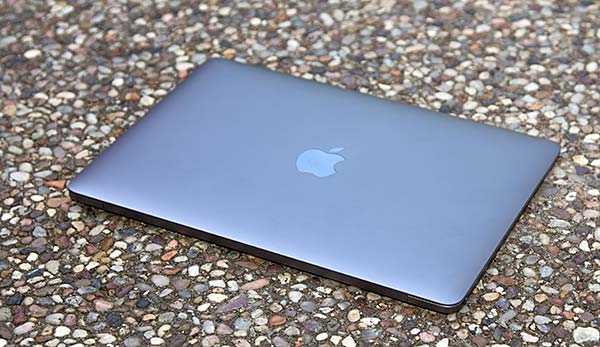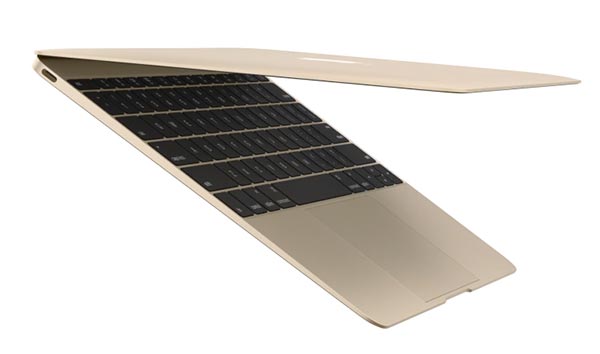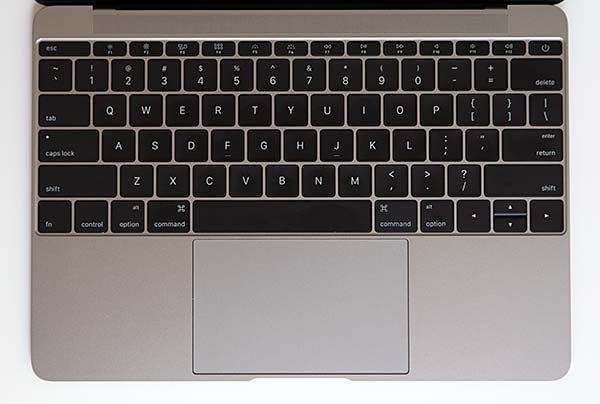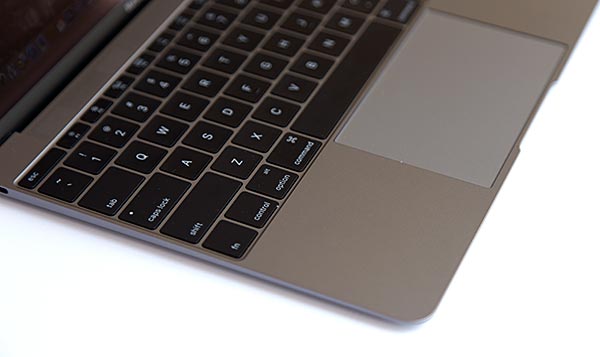|
Update, April 2016: read our review of the 2016, second generation 12" Retina MacBook that replaces this model.
It's 2008 and Steve Jobs stands before a large audience. He pulls something out of a manila envelope--oh my God, it's a laptop! One so impossibly thin and compact that it fits in an interoffice envelope. And so the world of laptops was changed. Years later, Intel wanted to see Windows PC makers offer up something, anything that might compete, and the Ultrabook was born. Apple is hoping to change the world of mobile computing again with the MacBook, a 12" laptop that's not much larger or heavier than the first iPad, yet it's capable of getting real work done. Just as the original 13" MacBook Air was port-constrained, a little slow and expensive, so is the MacBook. Just as the Air had one of the best displays on a 13" laptop at the time, so the MacBook has a stunning Retina display. Like the Air, I wouldn't be surprised if the MacBook gained a port or two in the years to come, and the price might even come down in a few years.
The new Apple MacBook, or 12" MacBook or Retina MacBook (whatever you want to call it to differentiate from MacBooks of old) is as polarizing as it is striking. This 2 lb. laptop is one of the most gorgeous on the market, and one of the smallest. It sits between the iPad Air and 13" MacBook Air in terms of size, though functionally it's a Mac and not an iPad. In fact, we suspect Apple is targeting those of you who bought an iPad and keyboard as a laptop replacement, but have since realized it can't handle everything a laptop can. For $1,299 you get a 1.1 GHz Core M CPU with Turbo Boost to 2.4 GHz, 8 gigs of RAM and a fast PCIe 256 gig SSD. The $1,599 bumps the CPU 100 MHz and doubles storage to 512 gigs. Either way you get one of Apple's best displays in years, the 2304 x 1440 IPS Retina display exceeds 100% sRGB color gamut and it has excellent contrast and high brightness. The laptop has dual band WiFi 802.11ac, Bluetooth 4.0 and a just OK 480p webcam.

Portability Focus
What do you get for your money? Not horsepower and not a huge screen. This is meant to be a second computer for folks who have an adequately large and powerful main desktop or laptop. You get a head-turning design, incredible portability (it weighs as much as in iPad Air in a case and takes up virtually no room in a bag) and a phenomenal screen. You certainly don't get ports: it has just a 3.5mm audio jack and a single USB-C port that also handles charging. Like the MacBook Air that Steve Jobs slipped out of a manila envelope in 2008, it's pricey, port constrained and not wildly powerful. Like the Air, it's an attention-getter and a feat of engineering, though some might wonder if this little guy is just too small.
Design and Ergonomics
It's an Apple Mac, and that means exquisite attention to design, fit and finish. There are no gaps, unsightly seams or pointless design elements. It's clean, well balanced and comfortable in the lap and easy to pass around when open or closed. The lid isn't difficult to open with one hand and the hinge is firm yet not stiff. The machine is available in the usual Apple silver, Space Gray and gold, not unlike the iPhone 6 and iPad Air 2. All are attractive and have a matte aluminum finish that resists fingerprints and maintains grip.

As ever with recent Mac laptops, you can remove the bottom panel if you have a pentalobe screwdriver, but there's little point since RAM, the CPU and the SSD are soldered permanently onto the motherboard. The stacked battery isn't all that easy to remove either. The MacBook has a 3.5mm combo audio jack (headphones and mic in one) and a single USB-C port that supports HDMI and DisplayPort 1.2. You'll also use that port for charging via the included compact charger and USB-C cable. If you wish to connect USB peripherals, you'll need a USB-C to female USB adapter that Apple sells for $19 (other companies make them too, and they're often less expensive). You can't charge the laptop and use the USB port for a peripheral at the same time with the $19 adapter, instead you'll need the $79 AV adapter with a charging port, USB port and HDMI. I'm sure 3rd party companies will make all sorts of adapters for the MacBook, but keep in mind that the port doesn't support Thunderbolt, so you won't be able to use Apple's Thunderbolt display or any other Thunderbolt peripheral.
Force Touch Trackpad and Keyboard
The keyboard is just plain weird, yet it's good. I type thousands of words per week and I'm picky about keyboards. I didn't like the miniscule key travel at first, but after 20 minutes I acclimated and typed as well on the MacBook as I do on my 13" Retina MacBook Pro. Each key has a tactile click thanks to the butterfly mechanical switches under each key, and they provide tactile feel that makes up for the lack of travel. The backlit keyboard has an LED beneath each key for even lighting, and our unit's keys are very evenly lit in soft white (you can adjust keyboard backlight level).

Apple makes perhaps the best trackpad on a laptop, regardless of OS platform. Somehow they've managed to make it ever better with the Force Touch trackpad. It might sound like a gimmick, but it's actually more accurate and efficient. On normal trackpads just the bottom edge moves. For large trackpads, it's easy to have the hand and fingers wander higher, where it will do no good because the top half doesn't register clicks (unless you enable tap to click). With the Force Touch trackpad, you can click in any corner and there are four spring-like mechanisms under each spot. Yes, the trackpad actually does move just a little, and your mind will tell you it moves quite a bit thanks to the force feedback that creates the sensation of a tactile click (what Apple calls their Taptic engine--a cross between tap and haptic). You can even adjust the force setting in trackpad settings for a light, medium or heavy touch and feedback. The end result is a trackpad that feels even more responsive and precise. I generally hate clicking trackpads because it slows me down and the required force causes my pointing finger to wander, resulting in errors. Problem solved with the Force Touch trackpad. I've stopped using tap to click in fact, which was my old preferred method even though it wasn't very precise and sometimes resulted in accidental clicks.
Even more interesting, there's a secondary deeper click if you continue to press down with some force. That can bring up a word definition in quite a few programs and in Safari force-clicking on a link brings up a small preview of the web page. I'm sure Apple and third party developers will come up with even more uses.
Display
The superb 12" IPS display is a selling point for the MacBook, and it's likely one of the reasons folks will consider it strongly vs. the MacBook Air models with their lower resolution TN panels. This panel is every bit as good as the Pro MacBooks, and in fact it slightly exceeds them in color gamut at 102% of sRGB and 80% of Adobe RGB. Contrast is high, colors are accurate and saturated and the panel can get very bright (we measured 350 nits). The brightness ramp is a little odd and it doesn't get very bright until the last few ticks--perhaps Apple wants to conserve power.

The 16:10 aspect ratio "Retina" panel has a resolution of 2304 x 1440. Usually Apple does pixel quadrupling for Retina displays, so the effective "looks like" resolution is one quarter of the absolute panel resolution. That makes for efficient performance, but in this case Apple runs it higher at an effective 1280 x 800 resolution, and we set it to 1440 x 900 to match the 13" MacBook Air (that's also my preferred setting on the 13" MacBook Pro with Retina display). The machine can drive a 4K monitor at 30 Hz according to Apple, but we found that the Intel HD 5300 integrated graphics struggled a bit with both the laptop display on and anything higher than a 1920 x 1200 monitor attached. The MacBook really isn't for graphics pros who need to drive very large high resolution external displays--I'd go with the 13" Retina MacBook Pro or the 15" rMBP for that. Even the MacBook Air with Intel HD 6000 graphics can handle high res monitors, including Apple's Thunderbolt display, which the MacBook can't.
|
|

